A Product–Service System (PSS) can be considered as a combination of customer life cycle-oriented products and services that are provided by means of an extended value creation network. Such a business model fosters the transition from a tangible goods-dominant logic to an intangible goods-dominant one and accomplishes Circular Economy (CE) principles. In fact, the services interwoven with a product’s life cycle, especially those related to its use and End-Of-Life (EOL) phases, play a crucial role in the optimization of the environmental performances of a product through its whole life cycle. However, PSS solutions aimed at practically optimizing supply chain management have scarcely been addressed. In order to reduce this gap, here proposes a procedure based on the PSS Functional Matrix, the Screening Life Cycle Modelling (SLCM) method, and stock management theory to optimize aftermarket services based on market demand.
- product–service system (PSS)
- supply chain management
- aftermarket services
- PSS functional matrix
- life-cycle engineering
- customer demand
- customization
- screening life-cycle modelling
1. Background Analysis
- Customer care (e.g., information and remote technical support);
- Field technical assistance (e.g., maintenance operations); and
- Spare parts distribution, which requires specific management of both inventory and spare parts flow.
2. Case study Overview
- Hydraulic components, i.e., those parts that come into contact with the dialysis fluid
- Mechanical and electromechanical components, e.g., the motors necessary for correct functioning and operation
- Electronics and controls, e.g., electronic boards, processing units, monitors and keyboards
- Structural metallic and plastic components which form the chassis
- Blood components, e.g., the arterial–venous pump, probes, and exchangeable components such as filters, needles and dialyzer.
- The dialysis filter constitutes the most important part of the artificial kidney. It contains a semipermeable membrane that allows the exchange of solutes and water between the blood and the dialysis fluid, and its main functions are to pump blood and keep circulation under control, to cleanse the blood of waste substances, and to control fluidic pressure and the rate of removal of waste substances from the body.
- The extracorporeal blood circuit consists of vascular accesses (needles or catheters) along with a set of cables and accessories for blood circulation. Most dialysis centers use two cannulas, one to make the blood flow towards the dialyzer and one to bring clean blood back to the body.
- The dialysis fluid circuit consists of a solution composed of renal water, mineral salts, osmotically active substances, and buffer substances.
- The control monitor is the instrument that prepares the dialysis liquid in compliance with the appropriate physio-chemical characteristics, controls the blood circulation in the extracorporeal circuit, and supervises the entire hemodialysis process.
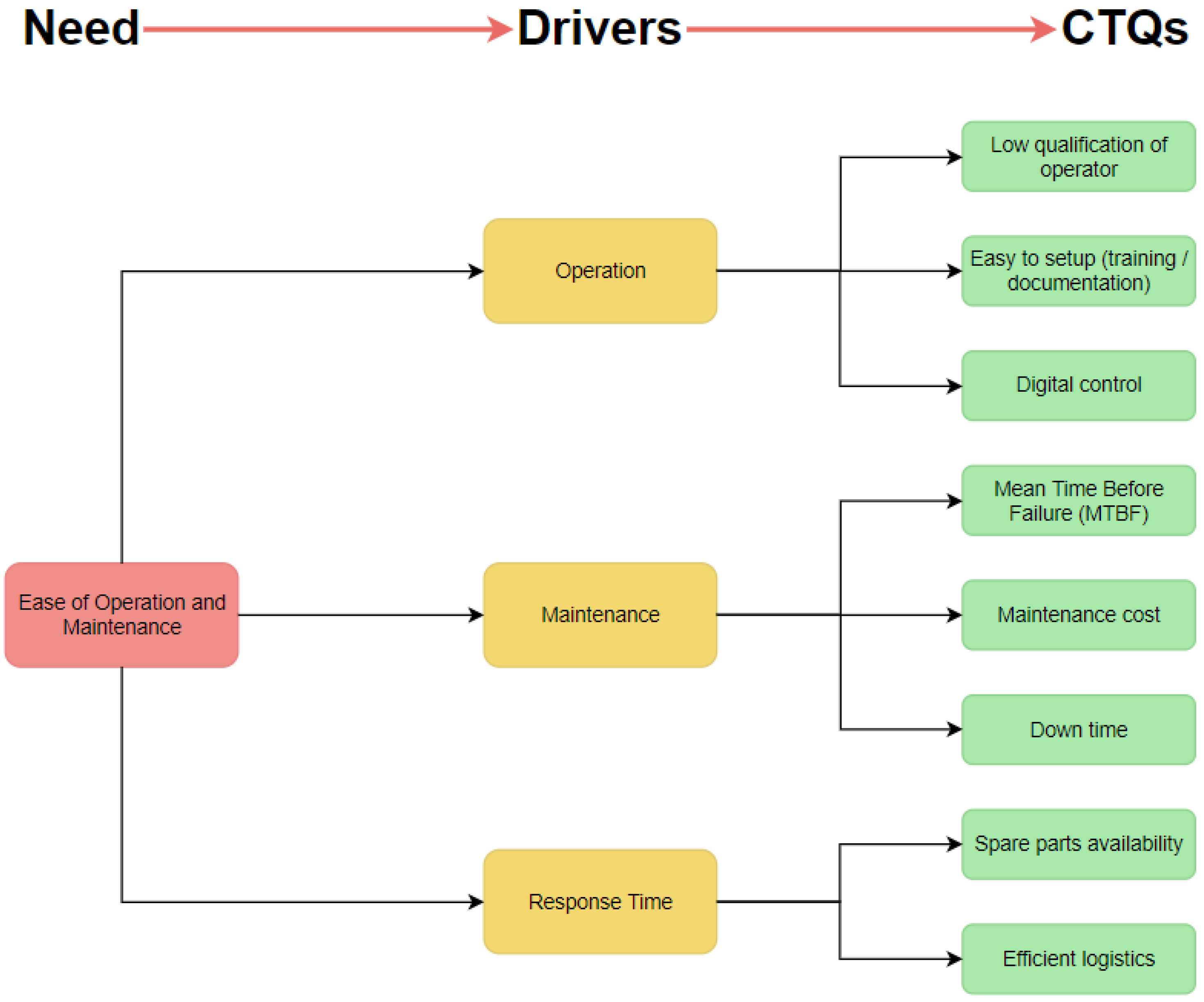
3. Current Business Model
- Product installation, including all activities for preparing the use of the device and its configuration
- Customer interaction, consisting of phone calls between the customer and the customer service operator, remote monitoring of product performance, and diagnosis activities
- Spare parts stock management, including stock planning, operational management of warehouses and shipments, and the management of return flows of materials
- Field service management, consisting of repairs and maintenance interventions which can be carried out either directly through internal technicians or indirectly via authorized third parties.

4. The PSS Alternative
| Area | Decision-Making Alternatives |
|---|
| EF | Product or Service Enablers | PSS Provider | ||||
|---|---|---|---|---|---|---|
| Base Scenario (BS) | ||||||||||
|---|---|---|---|---|---|---|---|---|---|---|
| Year | 0 | 1 | 2 | 3 | 4 | 5 | 6 | 7 | 8 | 9 |
| Distribution and territorial coverage of aftersales support | Service provision coverage based on geographical areas Segmentation based on type of customer |
|||||
| 1.1 | Online form | Call centre | / | Customer | Manufacturer | Third party |
| MO1 | x | x | x | x | x | x | x | x | x | |
| Technical assistance network ownership | Direct intervention by the manufacturer’s technicians of each branch |
1.2Indirect assistance through dealership workshops Secondary network of authorized and controlled workshops Indirect assistance through independent workshops |
||||||||
| Customer survey | Technical expert visit | / | Customer | Manufacturer | ||||||
| MO2 | ||||||||||
| Third party | ||||||||||
| x | x | x | x | |||||||
| Spare parts distribution network: number of levels | One level: supplier-central warehouse-customer. Two levels: supplier-central warehouse-peripheral warehouse-customer Two levels (mixed): supplier-central warehouse-customer OR peripheral warehouse-transit point-customers Three levels (mixed): supplier-central warehouse-peripheral warehouse-distribution center-customer |
|||||||||
| 2.1 | Purchase | Leasing | Temporary rental | Customer | Manufacturer | Third party | ||||
| EM1 | x | x | x | x | x | x | x | x | x | |
| Logistics operations outsourcing | Transport Inventory Spare parts planning and management Full outsourcing of logistics operations |
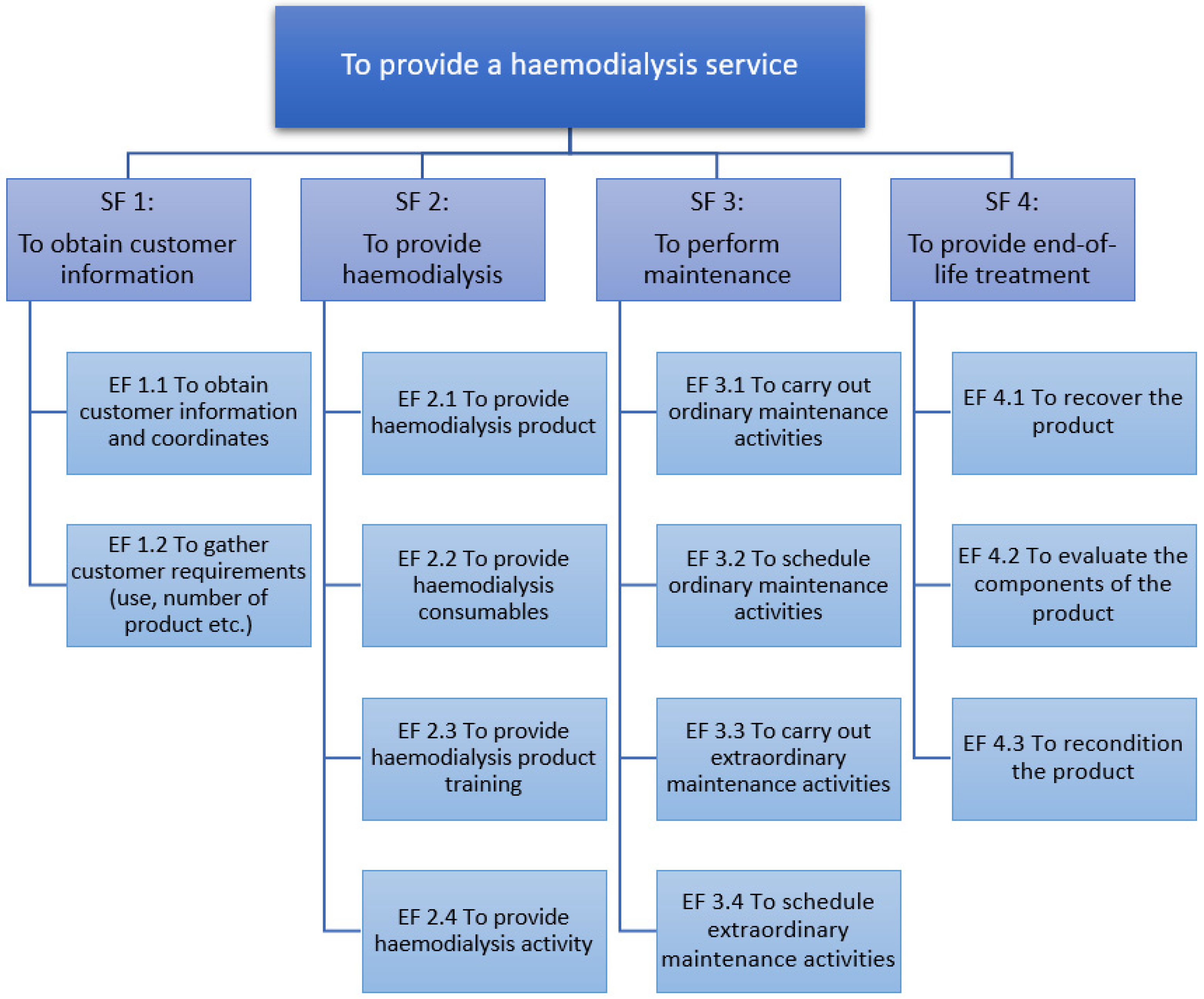
| 2.2 | ||||||||||
| EM2 | ||||||||||
| Forecast-based delivery service | ||||||||||
| On-demand delivery service | ||||||||||
| Purchase and pickup | ||||||||||
| Customer | ||||||||||
| x | ||||||||||
| Manufacturer | ||||||||||
| Third party | ||||||||||
| x | x | |||||||||
| 2.3 | Product manual | Training | / | Customer | Manufacturer | Third party | ||||
| Alternative Scenario (AS) | ||||||||||
| 2.4 | Haemodialysis product | / | / | Customer | ||||||
| Year | 0 | 1 | 2 | 3 | ||||||
| Manufacturer | ||||||||||
| 4 | ||||||||||
| Third party | ||||||||||
| 5 | 6 | 7 | 8 | 9 | ||||||
| 3.1 | Preventive maintenance | Predictive maintenance | Risk-based maintenance | Customer | Manufacturer | Third party | ||||
| MO1 | x | x | x | x | x | x | x | |||
| 3.2 | Customer interaction | Online form | Manufacturer recommendation | Customer | Manufacturer | |||||
| MO2 | x | |||||||||
| Third party | ||||||||||
| x | ||||||||||
| 3.3 | Deferred corrective maintenance | |||||||||
| EM1 | ||||||||||
| Immediate corrective maintenance | / | Customer | ||||||||
| Manufacturer | ||||||||||
| x | x | x | ||||||||
| Third party | ||||||||||
| x | x | x | x | |||||||
| 3.4 | Customer interaction | Online form | / | Customer | ||||||
| EM2 | ||||||||||
| Manufacturer | ||||||||||
| Third party | ||||||||||
| x | ||||||||||
| 4.1 | Shipping by customer | Field service intervention | None (scrap) | Customer | Manufacturer | Third party | ||||
| x | ||||||||||
| 4.2 | Engineer report | Computer-run diagnostic | Product disassembly | Customer | Manufacturer | Third party | ||||
| 4.3 | Worn parts replacement | Systematic replacement of all wearable parts | None (no wear and tear) | Customer | Manufacturer | Third party | ||||
- Yearly production: 700 products
- Product lifespan: 5 years
- Operational hours per year: 3000–3500 h (~15,000 to 18,000 h over five years)
- Yearly average of hemodialysis treatments: 624 h
| −0.29 |
- Ordinary Maintenance operations 1 (MO1) after 3000 h: connectors, joints. and solenoid valves
| Mechanical |
- Ordinary Maintenance operations 2 (MO2) after 6000 h: filters, connectors, joints, and solenoid dialysis valves
| −0.05 |
| Contractual |
- Extraordinary Maintenance (EM1): fluid pumps and inlet connections failing before their normal operational hours limit; the manufacturers’ information obtained via the customer services team shows an occurrence trend every 2800 to 3300 operational hours
- Extraordinary Maintenance 2 (EM2): pressure sensors and pressure valves; in this case, the information gathered indicates an average value of 7000–7500 h before occurrence
- Yearly number of ultrafilters: 18,000
- Operational duration of ultrafilters: 400 h. These are produced and maintained by the manufacturer; an authorized third party handles distribution and recovery, whereas the customers are responsible for their replacement during the use of the equipment.
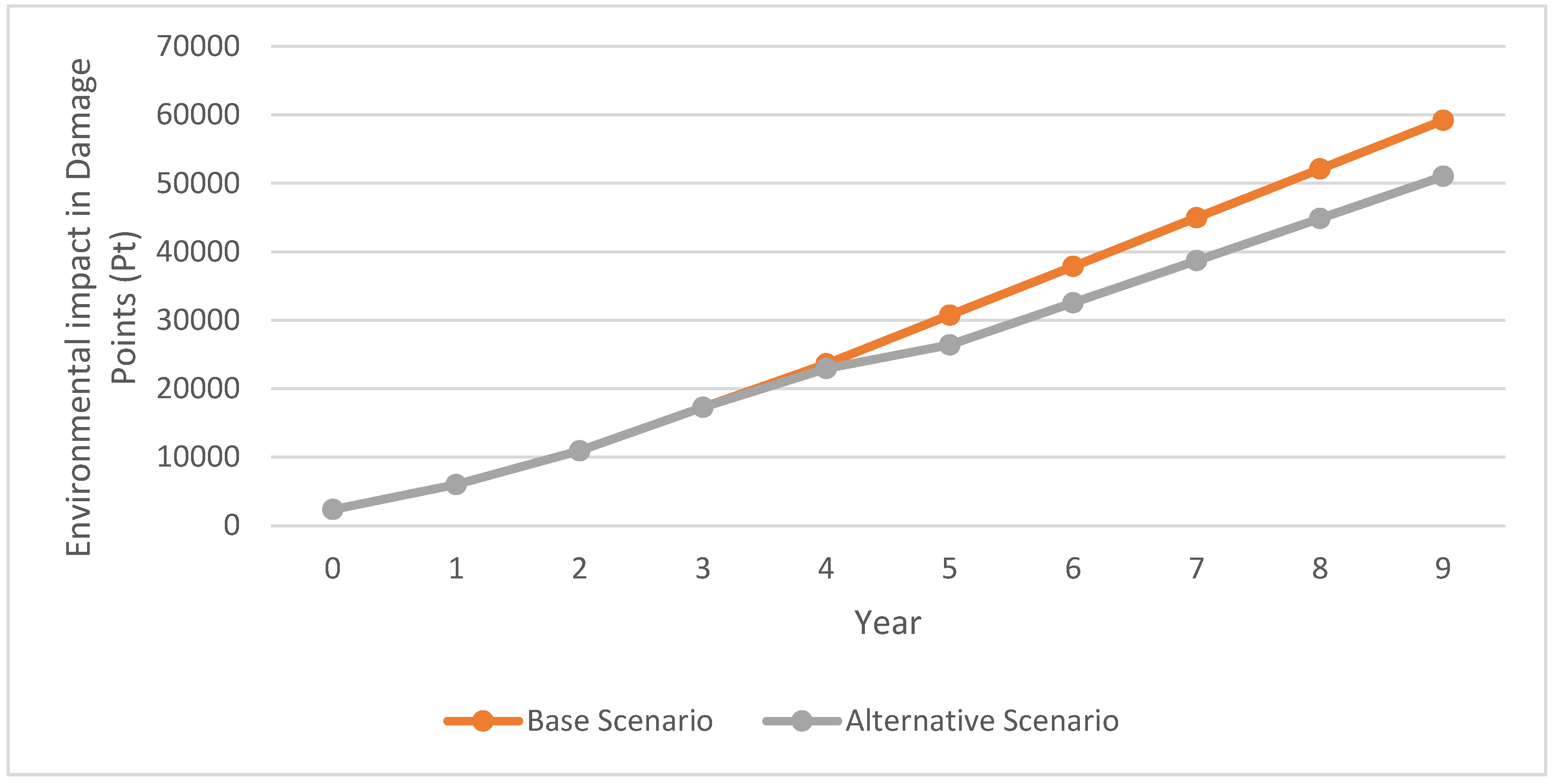
| Category | Unitary Cost (%) * |
|---|---|
| Manufacturing | |
| Packaging | 0.5 |
| Transport | 1 |
| Assembly | 1.5 |
| Maintenance | |
| Spare parts replacement | 11.9 |
| Transport | 4 |
| Labor | 3 |
| End-Of-Life | |
| Recovery | 1.5 |
| Transport | 1 |
| Electronic | −0.62 |
| Hematic | −0.12 |
| Structural | −0.24 |
| Hydraulic | |
| −1.5 | |
| Labor | 2 |
| Other costs | 76.42 |
5. Supply Chain Analysis
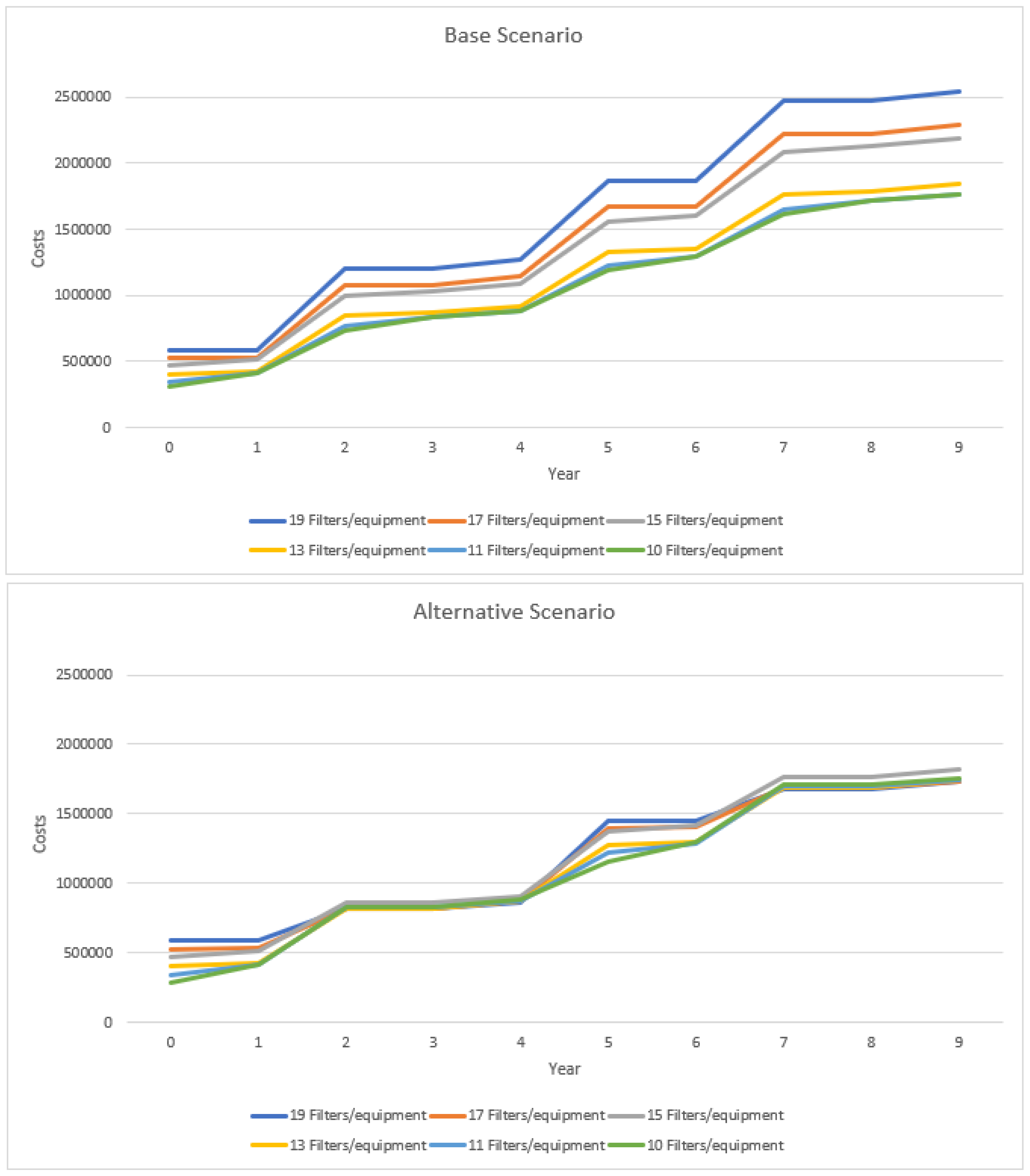
- For a distance up to 300 km from the central warehouse, the distribution of both spare parts and maintenance operations is provided by the manufacturer
- For distances greater than 300 km from the central warehouse the distribution is entrusted to third parties, whose costs are minor or at least equal to those borne by the manufacturer.
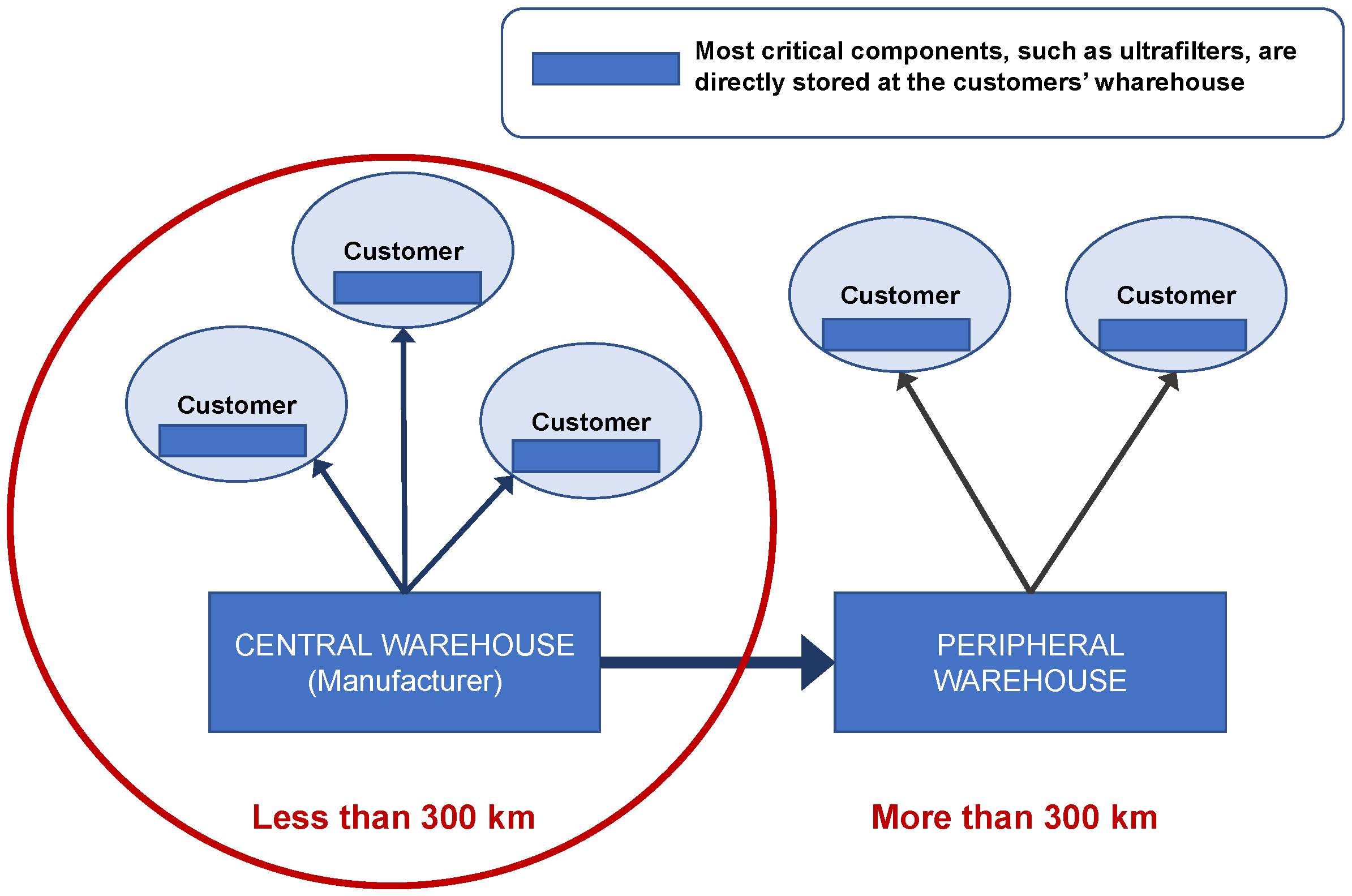
6. Conclusive Rremarks
In short, the current evidence contributed to demonstrating the effectiveness of the PSS approach in integrating CE with supply chain management, balancing economic benefits with customer value and environmental performance in line with the call for practical research. The proposed morphological approach, enables engineers to combine the two ‘souls’ of a PSS, i.e. the product and service characteristics, in a general and hands-on manner to obtain a comprehensive and unified solution.
References
- Cui, Z.; Geng, X. Product Service System Configuration Based on a PCA-QPSO-SVM Model. Sustainability 2021, 13, 9450.
- Feng, D.; Lu, C.; Jiang, S. An Iterative Design Method from Products to Product Service Systems—Combining Acceptability and Sustainability for Manufacturing SMEs. Sustainability 2022, 14, 722.
- da Costa Fernandes, S.; Pigosso, D.C.; McAloone, T.C.; Rozenfeld, H. Towards product-service system oriented to circular economy: A systematic review of value proposition design approaches. J. Clean. Prod. 2020, 257, 120507.
- Wang, N.; Ren, S.; Liu, Y.; Yang, M.; Wang, J.; Huisingh, D. An active preventive maintenance approach of complex equipment based on a novel product-service system operation mode. J. Clean. Prod. 2020, 277, 123365.
- Tukker, A. Product Services for a Resource-Efficient and Circular Economy—A Review. J. Clean. Prod. 2015, 97, 76–91.
- Tukker, A. Eight types of product service system: Eight ways to sustainability? Experiences from Suspronet. Bus. Strategy Environ. 2004, 13, 246–260.
- Reim, W.; Parida, V.; Örtqvist, D. Product–Service Systems (PSS) business models and tactics—A systematic literature review. J. Clean. Prod. 2015, 97, 61–75.
- Bellos, I.; Ferguson, M. Moving from a Product-Based Economy to a Service-Based Economy for a More Sustainable Future in Sustainable Supply Chains; Springer: Cham, Switzerland, 2017; pp. 355–373.
- Sigüenza, C.P.; Steubing, B.; Tukker, A.; Aguilar-Hernández, G.A. The environmental and material implications of circular transitions: A diffusion and product-life-cycle-based modeling framework. J. Ind. Ecol. 2021, 25, 563–579.
- Fargnoli, M.; Costantino, F.; Tronci, M.; Bisillo, S. Ecological profile of industrial products over the environmental compliance. Int. J. Sustain. Eng. 2013, 6, 117–130.
- Lindahl, M.; Sundin, E.; Sakao, T. Environmental and economic benefits of Integrated Product Service Offerings quantified with real business cases. J. Clean. Prod. 2014, 64, 288–296.
- Fargnoli, M.; Haber, N.; Sakao, T. PSS modularisation: A customer-driven integrated approach. Int. J. Prod. Res. 2019, 57, 4061–4077.
- Haber, N.; Fargnoli, M. Sustainable Product-Service Systems Customization: A Case Study Research in the Medical Equipment Sector. Sustainability 2021, 13, 6624.
- Sakao, T.; Hara, T.; Fukushima, R. Using Product/Service-System Family Design for Efficient Customization with Lean Principles: Model, Method, and Tool. Sustainability 2020, 12, 5779.
- Visnjic, I.; Jovanovic, M.; Neely, A.; Engwall, M. What brings the value to outcome-based contract providers? Value drivers in outcome business models. Int. J. Prod. Econ. 2017, 192, 169–181.
- Haase, R.P.; Pigosso, D.C.A.; McAloone, T.C. Product/Service-System Origins and Trajectories: A Systematic Literature Review of PSS Definitions and their Characteristics. Proc. CIRP 2017, 64, 157–162.
- Blüher, T.; Riedelsheimer, T.; Gogineni, S.; Klemichen, A.; Stark, R. Systematic Literature Review—Effects of PSS on Sustainability Based on Use Case Assessments. Sustainability 2020, 12, 6989.
- Haber, N.; Fargnoli, M. Designing product-service systems: A review towards a unified approach. In Proceedings of the International Conference on Industrial Engineering and Operations Management, Rabat, Morocco, 11–13 April 2017; pp. 817–837.
- Baines, T.; Ziaee Bigdeli, A.; Bustinza, O.F.; Shi, V.G.; Baldwin, J.; Ridgway, K. Servitization: Revisiting the state-of-the-art and research priorities. Int. J. Oper. Prod. Manag. 2017, 37, 256–278.
- Beuren, F.H.; Gomes Ferreira, M.G.; Cauchick Miguel, P.A. Product-service systems: A literature review on integrated products and services. J. Clean. Prod. 2013, 47, 222–231.
- Matschewsky, J.; Kambanou, M.L.; Sakao, T. Designing and providing integrated product-service systems-challenges, opportunities and solutions resulting from prescriptive approaches in two industrial companies. Int. J. Prod. Res. 2018, 56, 2150–2168.
- Kühl, C.; Bourlakis, M.; Aktas, E.; Skipworth, H. How does servitisation affect supply chain circularity?—A systematic literature review. J. Enterp. Inf. Manag. 2019, 33, 703–728.
- Cavalcante, J.; Gzara, L. Product-Service Systems lifecycle models: Literature review and new proposition. Proc. CIRP 2018.
- Durugbo, C.M. After-sales services and aftermarket support: A systematic review, theory and future research directions. Int. J. Prod. Res. 2020, 58, 1857–1892.
- Duval, D.; MacLean, H.L. The role of product information in automotive plastics recycling: A financial and life cycle assessment. J. Clean. Prod. 2007, 15, 1158–1168.
- Medina, L.A.; Kremer, G.E.O.; Wysk, R.A. Supporting medical device development: A standard product design process model. J. Eng. Des. 2013, 24, 83–119.
- Damha, L.G.; Trevisan, A.H.; Costa, D.G.; Costa, J.M.H. How are end-of-life strategies adopted in product-service systems? A systematic review of general cases and cases of medical devices industry. In Proceedings of the Design Society: International Conference on Engineering Design, Delft, The Netherlands, 5–8 August 2019; Volume 1, pp. 3061–3070.
- Jawahir, I.S.; Bradley, R. Technological Elements of Circular Economy and the Principles of 6R-Based Closed-Loop Material Flow in Sustainable Manufacturing. Proc. CIRP 2016, 40, 103–108.
- Gao, J.; Yao, Y. Service-oriented manufacturing: A new product pattern. J. Intel. Manuf. 2011, 22, 435–446.
- Gabriel, C.A.; Bortsie-Aryee, N.A.; Apparicio-Farrell, N.; Farrell, E. How supply chain choices affect the life cycle impacts of medical products. J. Clean. Prod. 2018, 182, 1095–1106.
- Ahmed, O.; Patel, K.; Rabei, R.; Patel, M.V.; Ginsburg, M.; Clayton, B.; Arslan, B. Hemodialysis access maintenance in the medicare population: An analysis over a decade of trends by provider specialty and site of service. J. Vasc. Interv. Radiol. 2018, 29, 159–169.
- Martinez, V.; Radnor, Z.; Cavalieri, S.; Gaiardelli, P.; Ierace, S. Aligning strategic profiles with operational metrics in after-sales service. Int. J. Product. Perform. Manag. 2007, 56, 436–455.
- Goedkoop, M.; Spriensma, R. The Eco-Indicator 99: A Damage Oriented Method for Life Cycle Impact Assessment—Methodology Report; Pré Consultants B.V.: Amersfoort, The Netherlands, 2001.
